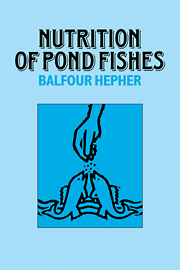Book contents
- Frontmatter
- Contents
- List of symbols
- Preface
- Introduction
- Part I FOOD REQUIREMENT
- 1 The balance of energy
- 2 Ingestion, digestion and absorption of food
- 3 Energy pathways
- 4 Maintenance
- 5 Growth
- 6 Requirement for protein
- 7 Other essential nutrients
- Part II FOOD SOURCES AND THEIR UTILIZATION
- Appendixes
- References
- Systematic index
- Subject index
2 - Ingestion, digestion and absorption of food
Published online by Cambridge University Press: 06 August 2010
- Frontmatter
- Contents
- List of symbols
- Preface
- Introduction
- Part I FOOD REQUIREMENT
- 1 The balance of energy
- 2 Ingestion, digestion and absorption of food
- 3 Energy pathways
- 4 Maintenance
- 5 Growth
- 6 Requirement for protein
- 7 Other essential nutrients
- Part II FOOD SOURCES AND THEIR UTILIZATION
- Appendixes
- References
- Systematic index
- Subject index
Summary
The alimentary canal
The food utilized by fish in natural habitats and ponds is very diverse, as also are their feeding habits. Some are carnivores, omnivores or detritivores. Some feed from the bottom, while others feed from the water column. As a result of their evolution, teleosts have developed special morphological and physiological characteristics to match their food and feeding habits. These adaptations are principally characterized by the morphology of the alimentary canal, but degree of relationship between the morphology of the alimentary canal and food taken varies. Different species with the same type of diet may differ in the structure of the alimentary system, but functional adaptations related to the nature of food and feeding habits usually remain similar. Morphological adaptations of fish to their feeding habits have been reviewed extensively by Kapoor et al. (1976a); some of these will be discussed here briefly.
Location of food
For most pond fishes chemoreception is most important for locating food, since sight is frequently quite poor in these fishes, especially in the turbid water of the pond. The gustatory system of the fish was well reviewed by Kapoor et al. (1976b). In teleosts taste buds are commonly found on the body and even on the fins. The number of taste buds may vary greatly from one part of the body to another, but the greatest number are found in the region most closely associated with food contact, namely, mouth, pharynx, lips, gill rakers, gill arches and barbels.
- Type
- Chapter
- Information
- Nutrition of Pond Fishes , pp. 16 - 63Publisher: Cambridge University PressPrint publication year: 1988



